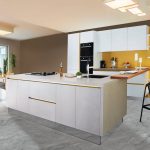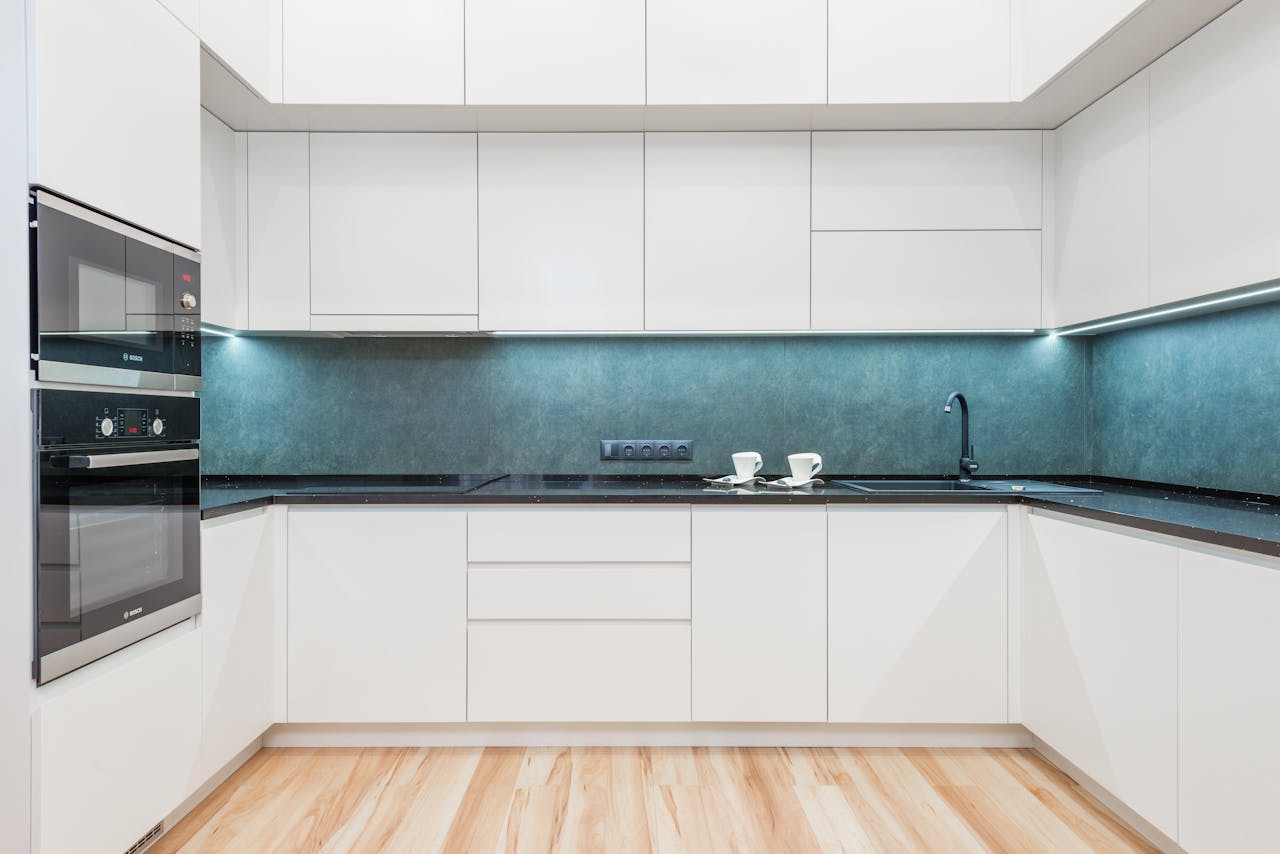In a bustling household, the kitchen is undoubtedly the heart of the home. It accommodates a multitude of daily activities, from coffee brewing in the morning to late-night snack runs. As such, the kitchen floor endures significant wear and tear from high traffic, spills, and drops. Selecting a suitable flooring material is crucial to ensure durability, ease of maintenance, and a design that complements your home’s style. In this article, we’ll explore the best flooring options for your high-traffic kitchen, including hardwood, vinyl, laminate, tiles, stone, and more.
Hardwood Flooring: Timeless Elegance
Hardwood flooring brings a warm, natural, and timeless look to any kitchen. It’s a top choice for homeowners who desire a seamless flow between the kitchen and other open areas of the house. Hardwood offers a plethora of options, from the red tones of cherry to the deep browns of walnut or the light, neutral hues of oak.
This might interest you : How to plan electrical outlets for maximum convenience in the kitchen?
Hardwood is a durable flooring option that can withstand high traffic areas. It’s straightforward to clean, as well, with most spills and stains easily wiped away. However, prolonged exposure to water can cause damage, so it’s important to immediately clean any spills. To extend the lifespan of your hardwood floor, consider adding a high-quality sealant to protect against wear and tear.
Solid hardwood can be sanded and refinished multiple times over its lifetime, allowing you to rejuvenate the floor’s look. Though costly initially, the long-term value of hardwood makes it a smart investment for many homeowners.
In the same genre : What are the current trends in kitchen cabinet hardware?
Vinyl Flooring: Affordable and Durable
Vinyl flooring has made significant strides in recent years, offering a range of styles that mimic the natural look of hardwood, stone, and tile at a fraction of the cost. Vinyl floors are durable, water-resistant and can handle heavy foot traffic, making them a popular choice for kitchens.
Luxury vinyl plank (LVP) and luxury vinyl tile (LVT) are high-end versions of vinyl flooring that offer more design options and improved durability. These flooring options have a wear layer that helps prevent scratches, stains, and wear, increasing their lifespan.
Vinyl flooring is also softer and warmer underfoot than many other flooring options, offering additional comfort in a room where you’ll often stand for extended periods.
Laminate Flooring: The Look for Less
Laminate flooring is a cost-effective alternative to hardwood and stone that doesn’t sacrifice aesthetics. With advanced printing technology, laminate can convincingly mimic the look of natural materials, providing the style of hardwood or stone without the high price tag.
Like vinyl, laminate flooring is durable and can handle high traffic. It’s resistant to stains, spills, and wear, making it a good fit for a busy kitchen. However, it’s important to note that laminate is not as water-resistant as vinyl, so spills should be cleaned up promptly to prevent damage.
Laminate flooring is also easy to install, making it a popular choice for DIY homeowners. However, unlike hardwood, laminate can’t be refinished if it’s damaged, so you may need to replace it sooner.
Tile Flooring: Classic and Versatile
Tile flooring, whether ceramic or porcelain, is a classic choice for kitchens. It’s highly durable, water-resistant, and available in a wide range of colors, patterns, and sizes. Whether you prefer a traditional checkerboard pattern or a modern, large-scale design, you’ll find a tile to fit your style.
Tiles can handle high traffic and are easy to clean. However, they can be cold and hard underfoot, so you might want to consider adding a layer of radiant floor heating, especially in colder climates.
Installation can be a complex process, requiring a skilled professional for the best results. However, if a tile breaks, you can replace it without disturbing the entire floor.
Stone Flooring: Naturally Beautiful
Stone flooring adds a touch of luxury to any kitchen. Natural materials such as granite, slate, or travertine, each with unique characteristics, add texture and visual interest to your kitchen.
Stone floors are incredibly durable and excellent for high-traffic areas. Plus, they’re naturally cool, which can be a bonus in hot climates. However, stone floors can be hard underfoot and cold in colder climates. They also require sealing to prevent staining.
Stone flooring is a significant investment but can add considerable value to your home. It is important to consider your budget, climate, and comfort preferences before opting for this flooring type.
Remember, the right kitchen flooring will not only enhance the aesthetics of your home but will also stand up to daily wear and tear while being easy to maintain. Consider the pros and cons of each material, your budget, and your lifestyle before making a decision.
Engineered Wood Flooring: A Compelling Alternative
Engineered wood flooring is growing in popularity as a kitchen flooring choice. This type of flooring is composed of a thin layer of hardwood bonded over high-quality plywood. This design allows the engineered wood to provide a similar look and feel to solid hardwood while offering superior stability and resistance to moisture.
Engineered wood flooring can handle heavy traffic and is less prone to expanding and contracting due to changes in humidity and temperature, which makes it ideal for kitchen areas. Its top hardwood layer comes in various species, styles, and finishes, allowing you to customize your kitchen floor to your exact preference.
This type of floor is generally easier to install than solid hardwood and can often be floated over your existing floor. While engineered wood flooring can be more expensive than laminate or vinyl, it tends to be cheaper than solid hardwood and offers similar longevity if properly cared for.
However, engineered wood has a thinner surface layer compared to solid hardwood, limiting the number of times it can be sanded and refinished. Therefore, it’s vital to protect your engineered wood floor from scratches and dents as much as possible.
The Ceramic Tile: Durable and Easy-to-maintain
Ceramic tile flooring is another great option for high-traffic kitchens. It’s renowned for its durability, resistance to water and stains, and ease of maintenance. Its hard, solid surface resists heat, humidity, and the most active households’ bustle, making it perfect for the kitchen environment.
Ceramic tiles come in a wide variety of shapes, sizes, colors, and patterns, allowing you to create a kitchen floor that’s truly unique. From small, intricate designs to large-format tiles, there’s a ceramic tile to suit every style and budget.
One significant advantage of ceramic tile flooring is its resistance to water and stains, which makes cleaning up spills and messes a breeze. However, the hardness of ceramic tiles can make them uncomfortable to stand on for extended periods.
Installation of ceramic tile flooring can be challenging and is best left to professionals. However, if a tile gets cracked or damaged, it’s relatively simple to replace without needing to uproot the entire floor.
Conclusion
Choosing the right flooring material for your high-traffic kitchen is a critical decision. The best flooring options are those that can stand up to daily use, are easy to maintain, and complement your home’s design aesthetic.
Hardwood flooring offers a traditional, timeless appeal; vinyl flooring provides affordability and durability; laminate flooring delivers a cost-effective alternative to hardwood and stone; tile flooring is a versatile option with a classic look, and stone flooring exudes natural beauty. Meanwhile, engineered wood flooring and ceramic tile flooring both present compelling alternatives with their own unique advantages.
Consider your household’s lifestyle, your kitchen’s usage, your aesthetic preference, and of course, your budget when deciding on the perfect kitchen flooring. With an array of flooring materials available, you’re sure to find a solution that’s both practical and stylish, ensuring your kitchen remains the heart of your home for years to come.






